PI Ceramic GmbH
Adaptronics – Industrial Applications of Tomorrow
The development of self-correcting, adaptive systems is receiving more and more attention in modern industrial research. Structures using “smart materials” which integrate sensor and actuator functions are taking on growing importance in this field. These systems are designed to detect and react to changes in their operating environment, like impact, pressure or bending forces.

With a long history as adaptive materials, piezo actuators have been especially popular for the monitoring and active damping of high-frequency vibration. The novel DuraAct™ patch transducers now offer a compact solution in this area.
Applied directly to a substrate, or used as part of the structure itself, DuraAct™ patch tranducers can detect and produce vibrations or contour deformations at the source, inside the structure. The magnitude of usable deflection depends strongly on the substrate properties, and extends into the millimeter range.
Piezo-Electric All-Rounder DuraAct™ Patch Tranducers
Piezoelectric components like the DuraAct™ patch transducer transform electrical to mechanical energy and vice versa. Possible applications are in high-precision bender actuators, high-dynamics sensors or as power sources.
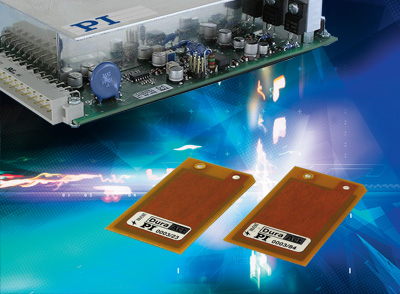
DuraAct™ patch transducers are extremely compact units based on a thin piezoceramic foil between two conductive films, all embedded in a ductile composite-polymer structure. In this way, the brittle piezoceramic is mechanically prestressed and electrically insulated, which makes the transducers so robust that they can be applied on curved surfaces with a bending radius as low as 20 mm. The patch transducers are glued to the surface and can be used for various purposes.
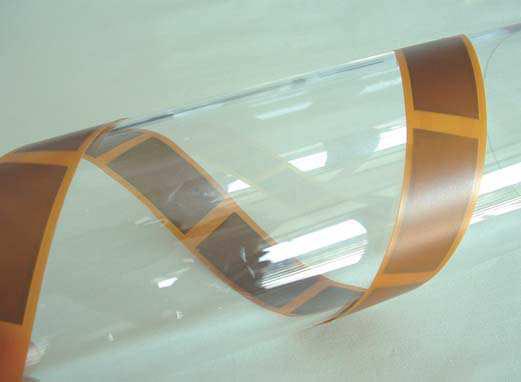
Even in high-dynamics applications, the rugged design ensures reliability, high resistance to damage and a lifetime well over 109 cycles. Wear and failure rates are low, as the solid-state actuators contain no moving parts.
Miniature Electric Generator for Autonomous Systems
DuraAct™ patch transducers can extract electric power from mechanical vibrations of up to several kilohertz, thus acting as energy harvesting devices. The power, in the milliwatt range, can supply miniature electronics like LEDs, sensors or mini RF transmitters for remote data transfer.
Custom Versions for Any Application
DuraAct™ technology allows high flexibility in actuator design. This means that DuraAct™ is also ideally suited for research and prototyping. In addition to the range of standard designs, highly individualized structural shapes can be realized to meet different requirements of geometry, flexibility, stiffness or operating temperature.
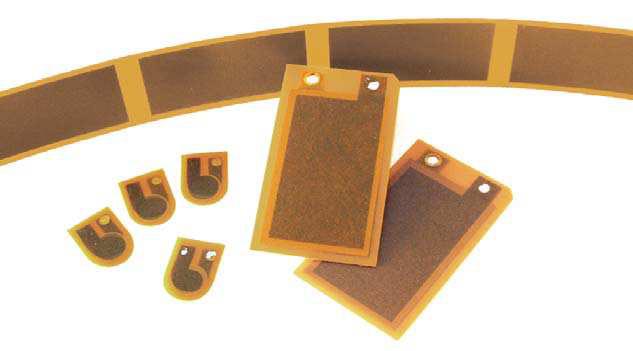
Standard DuraAct™ patch transducers consist of one piezoceramic layer only. For special applications, multilayer devices can be made available. In an actuator, multiple layers result in higher force generation with the same operating voltage. If the layers are wired separately, both sensor and actuator functionality can be used simultaneously.
The piezoelectric transducers can be designed to fit the application exactly, including even transducers with arrays of multiple ceramic elements. Such custom products can be produced very efficiently, even in low quantities.
Tailored Control Electronics
Depending on the application, different demands are made on the electronics. To operate a high-precision, high-dynamics positioner, a low-noise, broadband amplifier is required. Active vibration damping requires fast servo-control with bandwidth sufficient for close-coupling the generated force to the structural mass to be damped.
PI offers special, high-resolution amplifier modules for DuraAct™ patch transducers, and can always create custom versions to meet special requirements.
DuraAct™ Patch Transducers—Features and Advantages:
- High damage immunity
- Choice of materials and geometries
- Well-defined mechanical and electrical properties
- Short lead-time availability
- Compact
- Long lifetime
- High bandwidth
- Customized solutions
- Can be applied to curved surfaces
- Cost-effective
- Constant & proven quality
- Easy to use
- Operation as actuator, sensor or power source
- Multilayer module, e.g. for actuator-sensor combination
- Highly flexible ceramic elements
Piezo Transducer Applications: Examples
Sensor Mode (Fig. 1a+b)
 |
|
| Figure 1. |
a) Classical application of the direct piezo effect. Minute deformations of the substrate cause displacements in the DuraAct™ patch transducer and produce an electric current proportional to the motion. DuraAct™ transducers can detect deformations – like those caused by bending strain or pressure – very precisely, even at high frequencies. b) The same operating mode can be used with an array of several modules. |
Vibration damping applications: good results can be achieved by combining a piezoelectric sensor with a servo-controller and having the sensor signal control an (external) damping mechanism.
- Structural Health Monitoring (SHM): DuraAct™ patch transducers can be used to monitor the functional and structural integrity; the patch transducers are either part of the structure itself, or embedded within it.
- Fast switching: DuraAct™ patch transducers provide fast response and long lifetime and are ideal actuators for these applications.
Actuator Mode (Fig. 2)
 |
|
| Figure 2. | In actuator mode, DuraAct™ patch transducers use the inverse piezo effect: they contract when voltage is applied. Affixed to a substrate material, a DuraAct™ patch transducer acts as a bender. |
DuraAct™ patch transducers feature a very high bandwidth. In combination with suitable electronics (e.g. E-413.D2 from PI) they can be used as highdynamics positioners with submicron precision.
Structural Health Monitoring (Fig. 3)
 |
|
| Figure 3. | Design principle for a health monitoring system: one DuraAct™ patch transducer is controlled by an electronic amplifier (actuator functionality) and induces vibrations in the substrate. An array of transducers detects the vibrations and transfers the signals to suitable control electronics. Comparison with the signal pattern from an undamaged system gives information concerning the condition of the substrate. |
Whole areas can be surveyed with an array of multiple modules attached to various points on the surface. Active monitoring, where some transducers are used as actuators while the others detect the waves they generate, is also possible. Faults in the structural material, like microcracks, are detected by comparing the signals with those from an undamaged system.
Adaptive Systems Use Both Sensors and Actuators
- Active Vibration Damping: A DuraAct™ patch transducer is used as high-precision sensor and high-performance actuator, simultaneously detecting and damping or eliminating undesirable vibrations in, for example, rotating components. The DuraAct™ sensor signal may be used as power supply for the same module, where it is fed back in with a phase shift. Multilayer ceramic designs make for higher efficiency.
- Profile or shape control: The sensor functionality is used to detect a deformation, and the actuator function to counteract it. The resulting shape control is highly precise, down to the submicron range.
Adaptronics
The use in adaptive structures exploits both the sensor and actuator functionality of the DuraAct™ patch transducer. As smart materials, they can adapt to varying environmental conditions like impact, bending or pressure. Adaptive materials are used in particular for vibration reduction in vehicles, and their use in mechanical engineering is growing.
Energy Harvesting (Fig. 4)
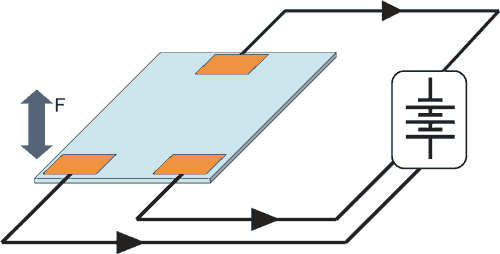 |
|
| Figure 4. | The ability of DuraAct™ transducers to convert mechanical to electrical energy makes them ideal for satisfying power requirements of low-power electronics, and makes possible construction of energy-autonomous systems. |
- DuraAct™ patch transducers can provide power for low-power electronics like sensors, making the development of autonomous systems possible.
- A special branch of Structural Health Monitoring (SHM) is Wireless Health Monitoring. Here, a DuraAct™ patch transducer can serve simultaneously as shape-control sensor and supply energy to a radio transmitter for remote data transfer. DuraAct™ patch transducers may replace other power supply solutions in existing applications.
Piezo Transducer Tutorial: Patch Transducers
Working Principle
The term piezo is derived from the Greek word for pressure. In 1880 Jacques and Pierre Curie discovered that an electric potential could be generated by applying pressure to quartz crystals; they named this phenomenon the piezoelectric effect. Later they ascertained that when exposed to an electric potential, piezoelectric materials change shape.
This they named the inverse piezoelectric effect.
The piezo effect is used for sensor functionality, while actuator behavior uses the inverse piezo effect.
 |
|
| Figure 5. | Lateral contraction. |
The piezoceramic plates in DuraAct™ patch transducers resemble a capacitor. The ceramic acts as a dielectric between its metallized surfaces. When voltage is applied, an electric field is created inside the ceramic. The field causes a uniform lateral contraction of the ceramic perpendicular to the direction of the electric field (Fig. 5). This behavior is called the transverse piezoelectric effect (d31 effect, Fig.6).
 |
|
| Figure 6. | d31 effect. |
The electric field strength determines the magnitude of the lateral contraction. This is the key to simple control of the transducer modules. When the modules are glued to a substrate, they effectively transfer force over the whole surface, not only at selected points, as with conventional actuators. Conversely, DuraAct™ patch transducers transform changes in shape to electric current, thereby enabling their use as sensors or energy sources.
The piezoceramic response to a change of the electric field or to deformation is extremely fast. Vibrations in the kilohertz range can be produced or detected. Different excitation voltages are required and different contraction amounts possible, depending on the ceramic type and its dimensions. The correlation between displacement and applied voltage is not linear. A voltage-to-displacement curve with the typical hysteresis behavior is shown in Fig. 7.
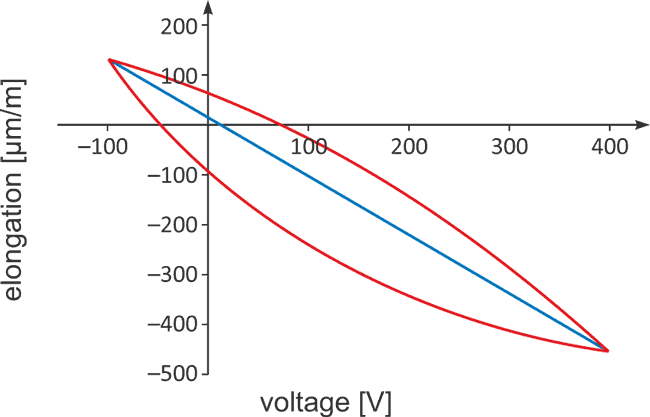 |
|
| Figure 7. | Piezo hysteresis. |
Technology
DuraAct™ piezo transducers operate as sensors with varying bandwidths – reacting to mechanical strain like impact, bending or pressure – and as high-precision positioning or bending actuators.
The standard transducer design features a piezoceramic foil with metalized surfaces for electrical contact (Fig. 8). The thickness of standard foils used is typically 100 to 500 ìm, with even thinner layers possible. Without further processing, these piezoceramic elements are brittle and difficult to handle. Embedding them in a polymer structure provides electrical insulation and mechanical stability. The result is a module that is ductile and extremely robust.
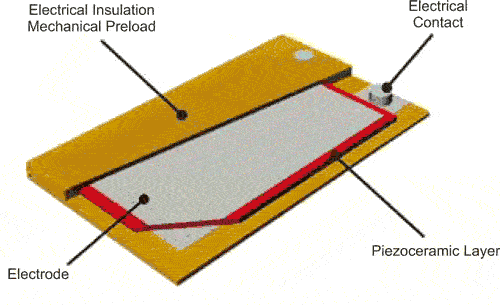 |
|
| Figure 8. | DuraAct transducer design principle. |
An alternative design features multiple layer piezoceramics, enhancing force generation for the same operating voltage.
DuraAct™ piezoelectric transducers are solid state actuators and therefore have no moving parts. Wear and failure rates are low. Electrical contact is realized by soldering, clamping or gluing leads to two pads. Connecting multiple layers separately allows separation of the sensor and actuator functionality, meaning that the transducer can be used as sensor and actuator simultaneously.
Working Diagram
The actuator properties of piezoceramic transducers are essentially described by two parameters: the blocking force FB and the free displacement, S0. When a voltage U is applied to the free (unblocked) actuator, it reaches its maximum displacement S0. The force required to prevent any length change at all is called the blocking force, FB (Fig. 9).
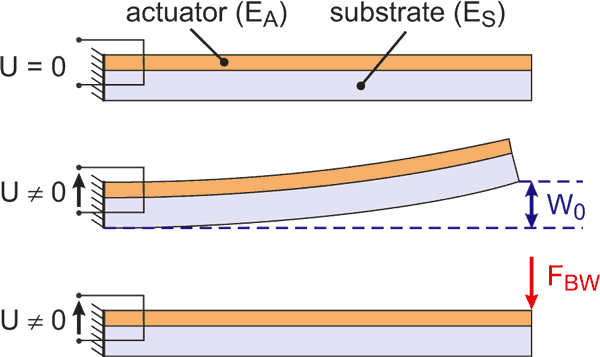 |
|
| Figure 9. | Parameter definitions. |
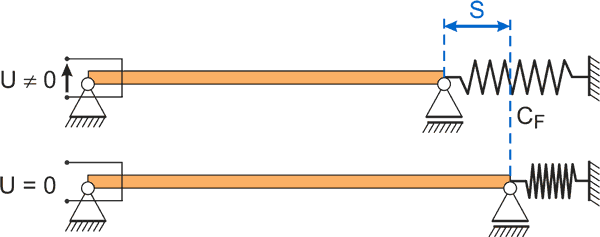 |
|
| Figure 10. | Application of a spring force to an actuator. |
A graph of applied force versus actuator displacement is called the actuator characteristic curve (Fig. 11). It basically follows the line passing through the points with 0 force and 0 displacement described above. In most cases the actuator acts against an elastic structure, e.g. when a spring or a metal sheet is deformed (Fig. 10). If the load is represented by a spring (characteristic curve of the spring) with stiffness of CF, the resulting operating point is the intersection of the load line with the actuator characteristic curve (Fig. 11). The most effective operation occurs when the operating point is in the middle of the characteristic curve.
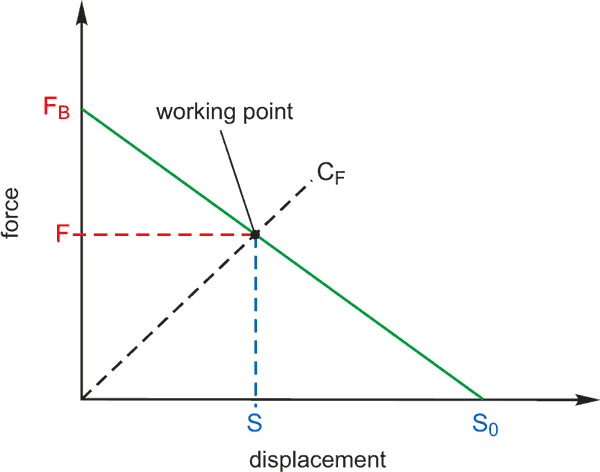 |
|
| Figure 11. | Characteristic curve with spring load line. |
Parameters for Bender Actuators
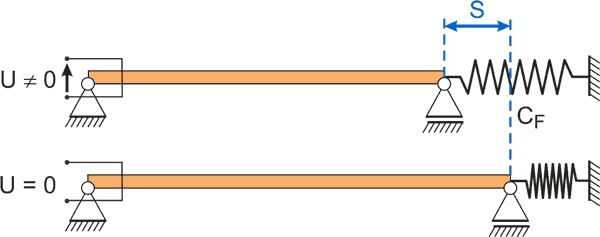 |
|
| Figure 12. | Bender actuator characteristics. |
DuraAct™ actuators are usually glued to a substrate and transfer the contraction not at a few attachment points, but over the whole surface. In such a configuration, the DuraAct™/ substrate combination acts as a bender actuator. Bender actuators provide fast, high-precision and repeatable deflection and are used in a wide range of applications, e.g. in printers, valves, and in the textile industry. DuraAct™ patch transducers are based on the transverse piezo effect, and therefore contract with an electric field applied. The bender flexes and exerts a normal force as shown in Fig. 12. For the free, unblocked bender, the free deflection is W0. The force required to reduce the deflection to zero is called the bender blocking force FBW. It is significantly smaller than the actuator blocking force. The line through these two points, gives the characteristic curve for the bender. Fig. 13 and 14 show curves relating the maximum deflection W0 and the maximum force FBW to the substrate thickness and elasticity. These diagrams show the actual deflections and forces measured with 50 mm substrate samples made of different materials and a P-876.A15 DuraAct™ patch transducer. Together with the characteristic curve for the DuraAct™ alone, the bender characteristics form the basis for effectively estimating the actuator performance in a specific application. PI therefore includes these curves on all datasheets.
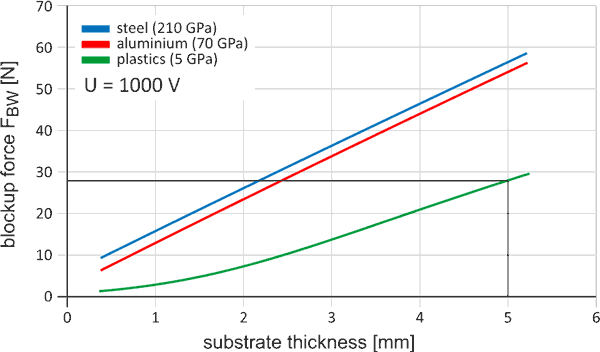 |
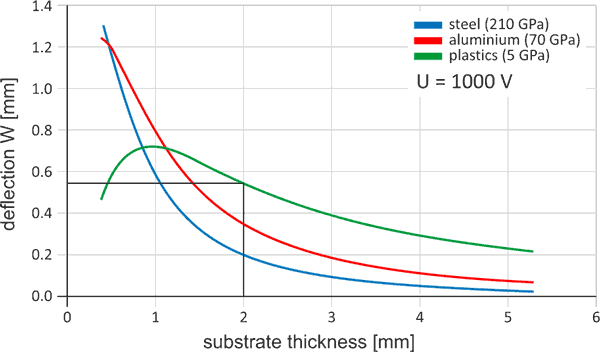 |
||
| Figure 13. | Free deflection of bender actuators. | Figure 14. | Bender actuator blocking force. |
Power Requirements
To determine the required electrical power for successful actuator operation, the electrical capacitance must be known. Typical DuraAct™ capacitances are in the nanofarad range and can be found in the datasheets. The electrical capacitance, C, depends on the piezoceramic type, thickness and area. For an estimation of the average electrical power, Pm, knowledge of the operating voltage range and the excitation frequency is necessary.
![]()
f: Frequency
Uh: Voltage swing
The maximum power required (Pmax) is then just the average power times π :
![]()
